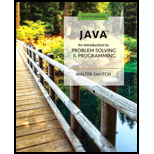
Concept explainers
Explanation of Solution
Exception class:
The exception class to find whether the time entered is valid or not. The time should be in the format “hour:minute” followed by “am” or “pm”.
InvalidFormattingException.java:
//Create a class that extends Exception
public class InvalidFormattingException extends Exception
{
//Define a parameterized constructor
public InvalidFormattingException(String reason)
{
//Call the parent class's method by passing a message
super(reason);
}
}
Explanation:
The above class “InvalidFormattingException” occurs when the time entered by the user in invalid.
Complete program:
Main.java:
//Import required packages
import java.util.*;
import java.util.Scanner;
//Define the main class
class Main
{
//Declare required variables
private int hour, minute;
private boolean isAM;
//Constructor
public Main()
{
//Instantiate the values
hour = 0;
minute = 0;
isAM = false;
}
//Function definition to set the time
public void setTimeTo(String aTime) throws InvalidFormattingException
{
//Declare required variables
int hourFound;
int minuteFound;
String indicatorFound;
//Create an object for the scanner class
Scanner reader = new Scanner(aTime);
//Split using the delimiter
reader.useDelimiter(":");
//Try block
try
{
//Assign the hour
hourFound = reader.nextInt();
}
//Catch the exception
catch (Exception e)
{
//Throw the exception with a message
throw new InvalidFormattingException("Hour not an integer");
}
//Get the remaining string
String restOfString = reader.next();
reader = new Scanner(restOfString);
//Remove the last two characters
if(restOfString.length()<3)
//Throw the exception
throw new InvalidFormattingException("Bad format");
//Get the substring
String minuteString = restOfString.substring(0, restOfString.length()-2);
//Get the substring
String amString = restOfString.substring(restOfString.length()-2);
//Try block
try
{
//Convert the minute to integer
minuteFound = Integer.parseInt(minuteString);
}
//Catch the exception
catch (Exception e)
{
//Throw the exception
throw new InvalidFormattingException("Minute not an integer");
}
//Check condition
if(!amString.equals("am") && !amString.equals("pm"))
//Throw the exception with a message
throw new InvalidFormattingException("Did not have am/pm");
//Assign the value
hour = hourFound;
//Assign the value
minute = minuteFound;
//Check if the string is am
if(amString...
Want to see the full answer?
Check out a sample textbook solution
Chapter 9 Solutions
Java: An Introduction to Problem Solving and Programming (8th Edition)
- 2:21 m Ο 21% AlmaNet WE ARE HIRING Experienced Freshers Salesforce Platform Developer APPLY NOW SEND YOUR CV: Email: hr.almanet@gmail.com Contact: +91 6264643660 Visit: www.almanet.in Locations: India, USA, UK, Vietnam (Remote & Hybrid Options Available)arrow_forwardProvide a detailed explanation of the architecture on the diagramarrow_forwardhello please explain the architecture in the diagram below. thanks youarrow_forward
- Complete the JavaScript function addPixels () to calculate the sum of pixelAmount and the given element's cssProperty value, and return the new "px" value. Ex: If helloElem's width is 150px, then calling addPixels (hello Elem, "width", 50) should return 150px + 50px = "200px". SHOW EXPECTED HTML JavaScript 1 function addPixels (element, cssProperty, pixelAmount) { 2 3 /* Your solution goes here *1 4 } 5 6 const helloElem = document.querySelector("# helloMessage"); 7 const newVal = addPixels (helloElem, "width", 50); 8 helloElem.style.setProperty("width", newVal); [arrow_forwardSolve in MATLABarrow_forwardHello please look at the attached picture. I need an detailed explanation of the architecturearrow_forward
- Information Security Risk and Vulnerability Assessment 1- Which TCP/IP protocol is used to convert the IP address to the Mac address? Explain 2-What popular switch feature allows you to create communication boundaries between systems connected to the switch3- what types of vulnerability directly related to the programmer of the software?4- Who ensures the entity implements appropriate security controls to protect an asset? Please do not use AI and add refrencearrow_forwardFind the voltage V0 across the 4K resistor using the mesh method or nodal analysis. Note: I have already simulated it and the value it should give is -1.714Varrow_forwardResolver por superposicionarrow_forward
- Describe three (3) Multiplexing techniques common for fiber optic linksarrow_forwardCould you help me to know features of the following concepts: - commercial CA - memory integrity - WMI filterarrow_forwardBriefly describe the issues involved in using ATM technology in Local Area Networksarrow_forward
 C++ Programming: From Problem Analysis to Program...Computer ScienceISBN:9781337102087Author:D. S. MalikPublisher:Cengage Learning
C++ Programming: From Problem Analysis to Program...Computer ScienceISBN:9781337102087Author:D. S. MalikPublisher:Cengage Learning Microsoft Visual C#Computer ScienceISBN:9781337102100Author:Joyce, Farrell.Publisher:Cengage Learning,
Microsoft Visual C#Computer ScienceISBN:9781337102100Author:Joyce, Farrell.Publisher:Cengage Learning, EBK JAVA PROGRAMMINGComputer ScienceISBN:9781337671385Author:FARRELLPublisher:CENGAGE LEARNING - CONSIGNMENT
EBK JAVA PROGRAMMINGComputer ScienceISBN:9781337671385Author:FARRELLPublisher:CENGAGE LEARNING - CONSIGNMENT C++ for Engineers and ScientistsComputer ScienceISBN:9781133187844Author:Bronson, Gary J.Publisher:Course Technology PtrProgramming Logic & Design ComprehensiveComputer ScienceISBN:9781337669405Author:FARRELLPublisher:Cengage
C++ for Engineers and ScientistsComputer ScienceISBN:9781133187844Author:Bronson, Gary J.Publisher:Course Technology PtrProgramming Logic & Design ComprehensiveComputer ScienceISBN:9781337669405Author:FARRELLPublisher:Cengage Programming with Microsoft Visual Basic 2017Computer ScienceISBN:9781337102124Author:Diane ZakPublisher:Cengage Learning
Programming with Microsoft Visual Basic 2017Computer ScienceISBN:9781337102124Author:Diane ZakPublisher:Cengage Learning





